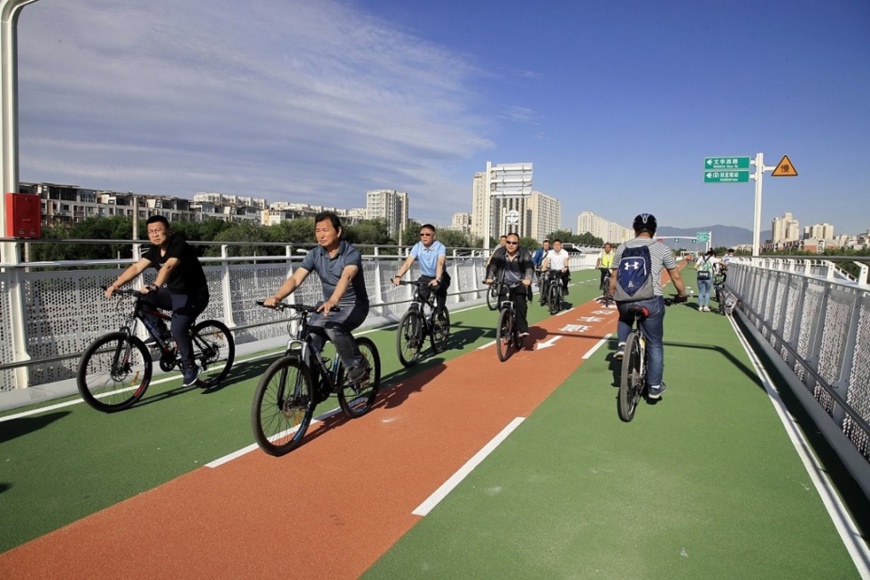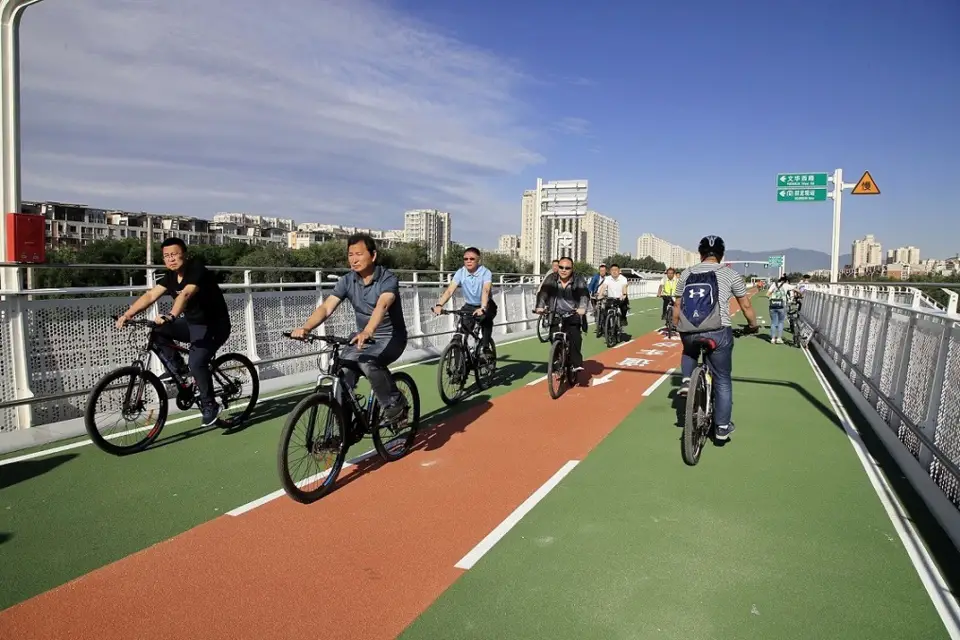By Qi Zhiming, People's Daily

Beijing's first dedicated bike lane was opened to traffic in May, 2019. It stretches 6.5 kilometers from Huilongguan, a densely populated community in the capital's northern Changping district and Shangdi, where a large number of high-tech companies are located. (Photo by Liu Xianguo/People's Daily Online)
Walking on a tree-lined sidewalk embellished with flower beds is definitely a pleasant experience that soothes your mood.
Today, green and low-carbon modes of transport have become a choice for more and more Chinese people as they see the convenience of urban pedestrian and bicycle systems.
To build sound pedestrian and bicycle systems, footpaths and bike lanes should be taken as an important part of urban transport. Science-based improvement of the systems can raise the class of a city, meet people's diversified demand for transportation, improve transport efficiency and lower vehicle exhaust emissions. It is beneficial for both social and economic development.
Green and low-carbon modes of transport have been largely promoted in China over recent years. For instance, between 2016 and 2020, Beijing has renovated 3,200 kilometers of non-motorized vehicle lanes and built its first bike-only path that stretches 6.5 kilometers. Last year, green transport made up 78 percent of the traffic in downtown Guangzhou, south China's Guangdong province.
Pedestrian and bicycle systems represent a low-carbon way of transport, and they also make public space better and more human-centered.
According to statistics released by the Chinese Cycling Association, cycling is joined by nearly 10 million people in China. To better meet people's demand for transportation, the country still needs to make more efforts to advance the construction of urban pedestrian and bicycle systems.
If trunk roads and public transport systems are an artery, then pedestrian and bicycle systems are capillaries. The two parts must work in close collaboration to make urban transport efficient.
More room shall be left for pedestrians and cyclists when urban plans are made, and public resources of different types shall be coordinated for better utilization of transport modes. Besides, footpaths and bike lanes must be designated in a science-based manner and connected to hospitals, schools, metro stations and other key areas.
Relevant facilities should be built to improve the safety of cyclists, such as reflective markers and high-friction surfacing. Traffic at crossroads should be maintained well, and more bike parking space should be offered. The right of way of cyclists and pedestrians must be ensured, and more shade trees should be planted to make pedestrian and bicycle systems more attractive and environmental-friendly.
Faster development of pedestrian and bicycle systems makes transportation greener and people's lives better. China should further prioritize pedestrian and bicycle systems, public transport and green transport, build "slow transport" networks that are friendly to both travelers and tourists, build a sound environment for pedestrians and cyclists, and make footpaths and bike lanes safe, convenient, comfortable and accessible to people of all ages, so as to contribute to the "dual carbon" goals and make urban life better.
Today, green and low-carbon modes of transport have become a choice for more and more Chinese people as they see the convenience of urban pedestrian and bicycle systems.
To build sound pedestrian and bicycle systems, footpaths and bike lanes should be taken as an important part of urban transport. Science-based improvement of the systems can raise the class of a city, meet people's diversified demand for transportation, improve transport efficiency and lower vehicle exhaust emissions. It is beneficial for both social and economic development.
Green and low-carbon modes of transport have been largely promoted in China over recent years. For instance, between 2016 and 2020, Beijing has renovated 3,200 kilometers of non-motorized vehicle lanes and built its first bike-only path that stretches 6.5 kilometers. Last year, green transport made up 78 percent of the traffic in downtown Guangzhou, south China's Guangdong province.
Pedestrian and bicycle systems represent a low-carbon way of transport, and they also make public space better and more human-centered.
According to statistics released by the Chinese Cycling Association, cycling is joined by nearly 10 million people in China. To better meet people's demand for transportation, the country still needs to make more efforts to advance the construction of urban pedestrian and bicycle systems.
If trunk roads and public transport systems are an artery, then pedestrian and bicycle systems are capillaries. The two parts must work in close collaboration to make urban transport efficient.
More room shall be left for pedestrians and cyclists when urban plans are made, and public resources of different types shall be coordinated for better utilization of transport modes. Besides, footpaths and bike lanes must be designated in a science-based manner and connected to hospitals, schools, metro stations and other key areas.
Relevant facilities should be built to improve the safety of cyclists, such as reflective markers and high-friction surfacing. Traffic at crossroads should be maintained well, and more bike parking space should be offered. The right of way of cyclists and pedestrians must be ensured, and more shade trees should be planted to make pedestrian and bicycle systems more attractive and environmental-friendly.
Faster development of pedestrian and bicycle systems makes transportation greener and people's lives better. China should further prioritize pedestrian and bicycle systems, public transport and green transport, build "slow transport" networks that are friendly to both travelers and tourists, build a sound environment for pedestrians and cyclists, and make footpaths and bike lanes safe, convenient, comfortable and accessible to people of all ages, so as to contribute to the "dual carbon" goals and make urban life better.
 Menu
Menu
 China improves pedestrian, bicycle systems for better, greener urban transport
China improves pedestrian, bicycle systems for better, greener urban transport
















